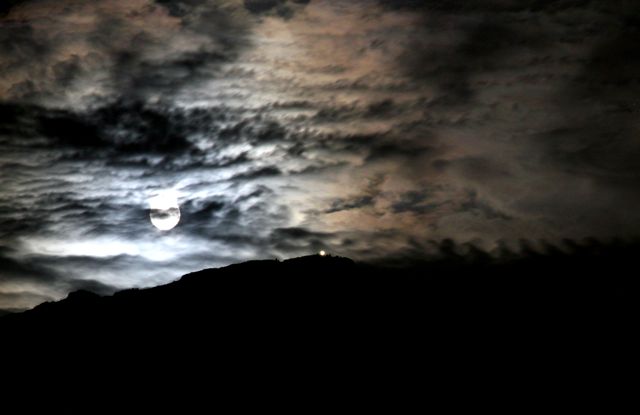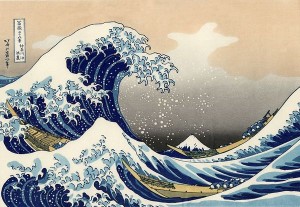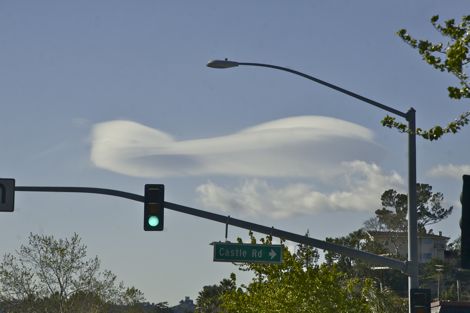What do aurora, noctilucent clouds, sun-dogs, and green flash have in common ? Answer: they’re all examples of rare and interesting visual atmospheric phenomena I’ve totally failed to observe this summer.

Conditions have often been right, even optimal. I’ve made repeated observations with sophisticated equipment: my eyes and a camera, but no joy. The only solace for standing in a field staring at the twilight horizon for nights on end has been the proximity of the local hostelry. On reflection not such a bad deal.
I’ve had better luck in the past, but more so with the moon than the sun. Take the example above of a lunar corona in the Swiss mountains. Snapped between avalanches from an improvised snow-hole during my ascent of the Eiger from the window of the Beau Rivage Hotel in Interlaken.
Lunar coronae are in no way attached to the moon, but are an earthbound visual effect caused by moonlight passing through clouds of small particles. As it’s a diffraction effect rather than a refraction effect, it works even with particles that don’t transmit light, like pollen grains for instance. In this case the effect is most likely caused by water droplets in clouds. The same thing happens with the sun sometimes, the visual ‘corona’ in that case not to be confused with the physical corona that is attached to the sun – so to speak.
Talking of confusion, lunar coronae, or moonbows, are not the same thing as Moon Rings. I made that mistake when I started writing this piece and subsequently had to change the title. A Moon Ring is just a name, but it’s a name specifically reserved for a ring of light caused by the refraction of moonlight through high altitude ice crystals. Because ice crystals are hexagonal in shape, they all refract light at the same angle, which from an observer’s viewpoint produces a ring concentric with the moon at a fixed radius of 22 degrees (for fuller explanation see here). Measured across the sky, that looks like 44 moons put next to each other (the moon takes up roughly half a degree of the 180 degrees of the sky we can see at any time). The ring in my picture is at most ten moon diameters from the moon’s disc, or five degrees. So it ain’t a Moon Ring.
A lunar corona can be more spectacular though, and if the conditions are right, a whole rainbow of colours can spread out from the inner ring, going from red to blue.
On a different tack now….
Apart from the moonbow, this scene includes an almost text-book perfect example of a mountain weather phenomenon known as Mountain Waves and Lenticular Cloud formation.

When air is forced to rise by flowing up the side of a mountain, it can cool down sufficiently, to the dewpoint temperature, where water vapour condenses to form clouds. (That is adiabatic cooling and cloud formation as first explained by Erasmus Darwin. Just sayin’.) When the air descends on the other side of the mountain, it warms up to above the dewpoint and the cloud disappears, the water drops vapourising again. The isolated cap left on top of the mountain is a lenticular cloud.
That said, what I think we’re seeing in the photo here is a special circumstance for lenticular cloud formation that I first came across as a trainee private pilot. In this case, air flowing over the mountains is trapped under a higher layer of stable air, causing standing waves to be set up, with lenticular clouds peeling off the cusps.

The same conditions generate a series of turbulent rotating eddies lower down on the lee side of the mountain which can cause so-called ‘rotor clouds’ or ‘roll clouds’ to form. It’s best not to fly anywhere near areas of rotating turbulence, so these clouds are good visual warnings for pilots to take special care (although as the mountain wave effect can extend 30 or forty miles downwind of a large range, you’re just as likely to feel the warning).
For a close-up view of a lenticular cloud, here is a lenticular altocumulus I snapped this summer floating off the leeward side of the San Gabriel Mountains in California. The bulges are caused by rotating air under the cloud.

That then about wraps it up for mountains and moonbows. Just to leave you in the true spirit of transparent open-book research and a view of the laboratory where the Swiss studies were made, complete with proof of location. And flowers.

Update November 2011 – Here’s another lunar corona; this time with Jupiter and taken from Kingston upon Thames:

Of related interest on external sites:
Rare Green Flashes Captured from the Moon (Universe Today)
http://www.sciencebase.com/science-blog/cloud-spotting.html
http://blogs.agu.org/wildwildscience/2011/12/17/magic-clouds-in-the-magic-city/